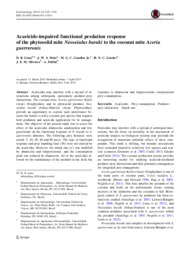Acaricide-impaired functional predation response of the phytoseiid mite Neoseiulus baraki to the coconut mite Aceria guerreronis.
Acaricide-impaired functional predation response of the phytoseiid mite Neoseiulus baraki to the coconut mite Aceria guerreronis.
Author(s): LIMA, D. B.; MELO, J. W. S.; GONDIM JÚNIOR, M. G. C.; GUEDES, R. N. C.; OLIVEIRA, J. E. de M.; PALLINI, A.
Summary: Acaricides may interfere with a myriad of interactions among arthropods, particularly predator?prey interactions. The coconut mite, Aceria guerreronis Keifer (Acari: Eriophyidae), and its phytoseiid predator, Neoseiulus baraki (Athias-Henriot) (Acari: Phytoseiidae), provide an opportunity to explore such interference because the former is a key coconut pest species that requires both predation and acaricide application for its management. The objective of the present study was to assess the effect of the acaricides abamectin, azadirachtin and fenpyroximate on the functional response of N. baraki to A. guerreronis densities. The following prey densities were tested: 5, 10, 20, 40 and 80 preys. The type of functional response and prey handling time (Th) were not altered by the acaricides. However, the attack rate (a0) was modified by abamectin and fenpyroximate, and the consumption peak was reduced by abamectin. All of the acaricides allowed for the maintenance of the predator in the field, but exposure to abamectin and fenpyroximate compromised prey consumption.
Publication year: 2015
Types of publication: Journal article
Unit: Embrapa Semi-arid Region
Keywords: Acaricides, Aceria guerreronis, Attack rate, Coco, Inseto, Predator, Prey consumption, Ácaro
Observation
Some of Embrapa's publications are published as ePub files. To read them, use or download one of the following free software options to your computer or mobile device. Android: Google Play Books; IOS: iBooks; Windows and Linux: Calibre.
Access other publications
Access the Agricultural Research Database (BDPA) to consult Embrapa's full library collection and records.
Visit Embrapa Bookstore to purchase books and other publications sold by Embrapa.

